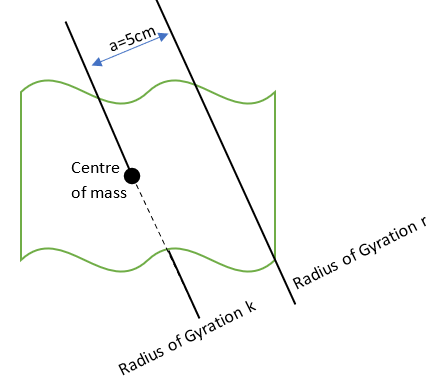
If the radius of gyration of the body about the axis at a distance $5cm$ from the center of mass is $13cm$ . What will be the radius of gyration about the parallel axis through the center of mass?
Answer
489k+ views
Hint: To solve this problem, we need to know the parallel axis theorem. The parallel axis theorem states that the Moment of Inertia of an object through an axis can be calculated by using the help of an axis that is parallel to it and passes through the center of mass of the object.
Complete step by step solution:
Step 1:
Let us assume that the Radius of Gyration of an axis passing through the center of mass be $k$ while the Radius of Gyration of the given axis passing at a distance of $5cm$ from the center of mass be $r$ .
Let us denote the distance of $5cm$ as a which is the distance between the axes.
Let the mass of the object be $m$
Step 2:
Given that $a = 5cm$
$r = 13cm$

Step 3:
By using parallel axis theorem
$m{r^2} = m{k^2} + m{a^2}$
By substituting the given values in the above equation,
We get
$m \times {13^2} = m \times {k^2} + m \times {5^2}$
As both sides have m, we can remove it and we get simplifies equation as
$ \Rightarrow {13^2} = {k^2} + {5^2}$
$ \Rightarrow {k^2} = {13^2} - {5^2}$
$ \Rightarrow {k^2} = 169 - 25 = 144$
$ \Rightarrow k = \sqrt {144} $
$ \Rightarrow k = 12$
Therefore, we get the value of $k = 12$ which is the radius of gyration of the object through the center of mass.
Note: A Radius of Gyration in general is the distance from the center of mass of a body at which the whole mass could be concentrated without changing its moment of rotational inertia about an axis through the center of mass.
Complete step by step solution:
Step 1:
Let us assume that the Radius of Gyration of an axis passing through the center of mass be $k$ while the Radius of Gyration of the given axis passing at a distance of $5cm$ from the center of mass be $r$ .
Let us denote the distance of $5cm$ as a which is the distance between the axes.
Let the mass of the object be $m$
Step 2:
Given that $a = 5cm$
$r = 13cm$

Step 3:
By using parallel axis theorem
$m{r^2} = m{k^2} + m{a^2}$
By substituting the given values in the above equation,
We get
$m \times {13^2} = m \times {k^2} + m \times {5^2}$
As both sides have m, we can remove it and we get simplifies equation as
$ \Rightarrow {13^2} = {k^2} + {5^2}$
$ \Rightarrow {k^2} = {13^2} - {5^2}$
$ \Rightarrow {k^2} = 169 - 25 = 144$
$ \Rightarrow k = \sqrt {144} $
$ \Rightarrow k = 12$
Therefore, we get the value of $k = 12$ which is the radius of gyration of the object through the center of mass.
Note: A Radius of Gyration in general is the distance from the center of mass of a body at which the whole mass could be concentrated without changing its moment of rotational inertia about an axis through the center of mass.
Recently Updated Pages
Master Class 11 Economics: Engaging Questions & Answers for Success

Master Class 11 English: Engaging Questions & Answers for Success

Master Class 11 Social Science: Engaging Questions & Answers for Success

Master Class 11 Biology: Engaging Questions & Answers for Success

Class 11 Question and Answer - Your Ultimate Solutions Guide

Master Class 11 Business Studies: Engaging Questions & Answers for Success

Trending doubts
What is meant by exothermic and endothermic reactions class 11 chemistry CBSE

10 examples of friction in our daily life

One Metric ton is equal to kg A 10000 B 1000 C 100 class 11 physics CBSE

Difference Between Prokaryotic Cells and Eukaryotic Cells

What are Quantum numbers Explain the quantum number class 11 chemistry CBSE

1 Quintal is equal to a 110 kg b 10 kg c 100kg d 1000 class 11 physics CBSE




